Dear Friends and Well-wishers,
Wishing you all a very Happy New Year.
We are beginning the new year with the publication of a very special article on the Samadhi of Sri Aurobindo and the Mother authored by Shri Gangaram Malwade, a senior inmate of Sri Aurobindo Ashram, Pondicherry, as well as some of the early photographs of the Samadhi and a special photograph in which the Mother is seen looking at the Samadhi in the online forum of Overman Foundation.
With warm regards,
Anurag Banerjee
Founder,
Overman Foundation.
The Story of the Samadhi of Sri Aurobindo and the Mother
Gangaram Malwade
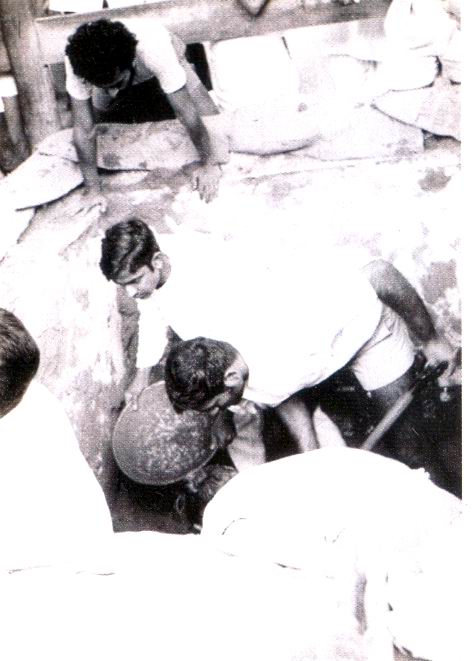
Photograph of Samadhi work in progress (6 December 1950).
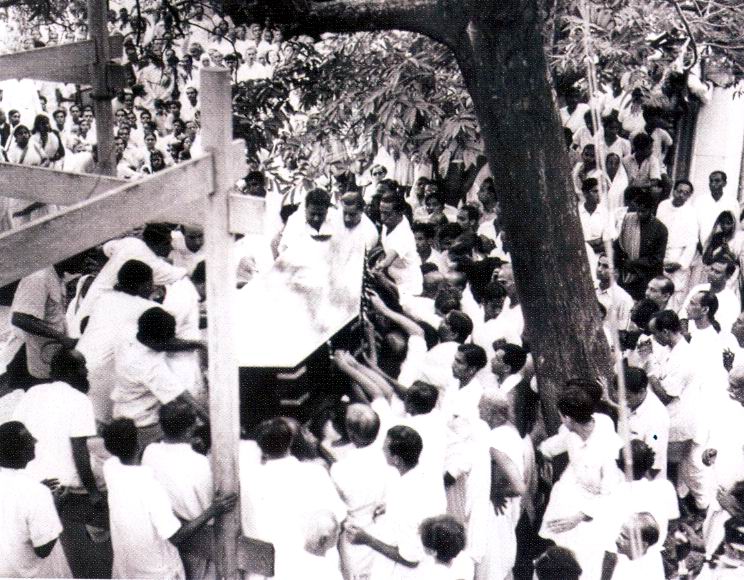
Photograph of Sri Aurobindo’s Casket being taken towards the Samadhi vault (9 December 1950).
Sri Aurobindo’s body was laid to rest on 9th December 1950 at about 4.00 p.m. and the top slab was sealed with waterproof material and flowers were offered on the top.
The next day, 10th December 1950, early in the morning a number of Ashramites came and arranged flowers on the Samadhi. At that time the flower room was inside the Ashram (now Pujalal’s room). Later, the flower room was shifted. As per the Mother’s instruction, one agarbatti (incense stick) was kept burning throughout the day and night and I was given the work of purchasing agarbatti’s from the market. About a year or so later, when our Cottage Industries started preparing agarbatti’s and offered them for the Samadhi, the purchasing from the market was stopped. Volunteers were given the work to take care of the Samadhi and to see that the place around the Samadhi was kept clean and one agarbatti was always kept burning. Everyday, fresh flowers were arranged on the Samadhi.
I was working in Enterprise (Manoranjan’s department) at that time and I was given time to work near the Samadhi for a few hours in the morning, and at noon and also at night. Ashramites and devotees would visit the Samadhi and do pranam from early morning, i.e. 4.30 a.m., when the Ashram gate opened up to 11.00 p.m., the time when the gate closed. Three persons were allowed to stay at night for duty near the Samadhi. The first person (I do not remember his name now, was on duty from 10.00 p.m. to midnight. Next, it was Dayabhai’s duty — from midnight to 2.00 a.m.; and my duty was from 2.00 a.m. to 4.00 a.m. At 4.00 a.m. some Ashramites used to come to arrange flowers on the Samadhi — even now it is continued. Our duty was to keep awake near the Samadhi and see that the agarbatti was kept burning continuously. This night duty continued only for about a month because Bula-da, who used to stay inside the Ashram premises, spoke to the Mother and took upon himself the responsibility of our work. So our night duty was discontinued.
During the daytime, especially in the mornings, people would bring flowers for the Samadhi, and do pranam. Many sadhaks used to came to the Samadhi for pranam before going for their work, or before going for Balcony Darshan of The Mother early in the morning. This was a routine.
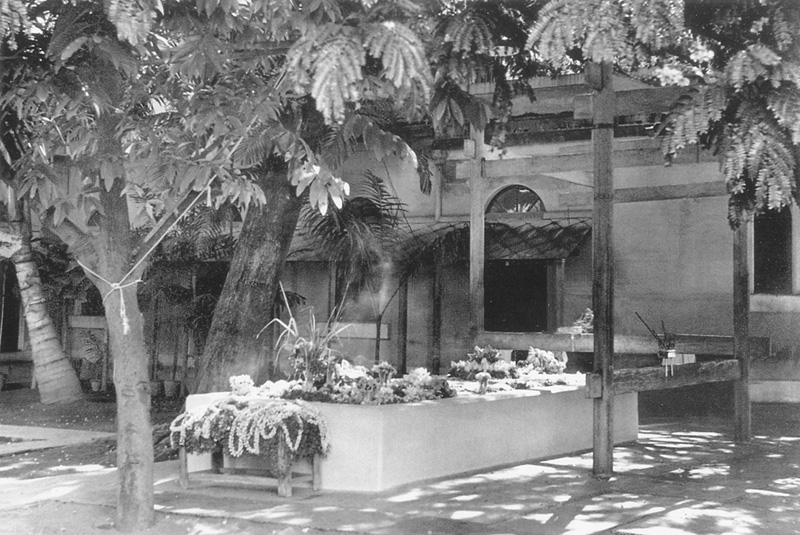
Sometime in late January 1951, we found that some who were coming to the Samadhi were bringing agarbattis; also, some coins were found placed on the Samadhi along with the flowers. This I reported to The Mother. She said, “If the people are offering coins, you better arrange to keep a small box on one corner of the Samadhi, so that they may put the money in the box rather then putting it in the flower decoration. In the meantime I shall ask Udar to prepare a small brass box in Harpagon and fix it near the Samadhi”. The Mother also told me to inform all those on duty to tell the persons who wanted to offer money, that they should put it in the box and not on the Samadhi flowers. I got a small marble box with a loose lid from Kameshwar Rao and kept it as a temporary measure on the north-east corner of the Samadhi. This is how the offering box started. About 4 or 5 days later i.e. on 27.01.1951 one brass box (6″x 3″ x 2 ½ ) was fixed near the Samadhi. The Mother gave me both the keys of the offering box and told me, “You will open the box everyday and bring the offerings to me on the next day in the morning when you come for pranam. I said “Yes Mother”.
In those days, the money was in Rupee-anna-pai denominations. I would collect the money at night and write the amount in a notebook, and offer it to The Mother the next morning. She would sign and write ‘Blessings’ in the notebook.
After few days someone brought a coconut and broke it in front of the Samadhi. Immediately I reported it to The Mother. She told me to stop that saying, “I don’t want religious activities here. You inform Reception Service.” I immediately came down and stopped the person and told him not to repeat it, then informed the Reception Service of The Mother’s words.
In the same way, after a few days, someone brought camphor and started burning it in front of the Samadhi. It was brought to The Mother’s notice. The Mother said, “I don’t want any fire here. Stop it. Only one agarbatti should burn day and night.” I told the person and stopped it and informed the Reception Service. Since then both these things are stopped for good.
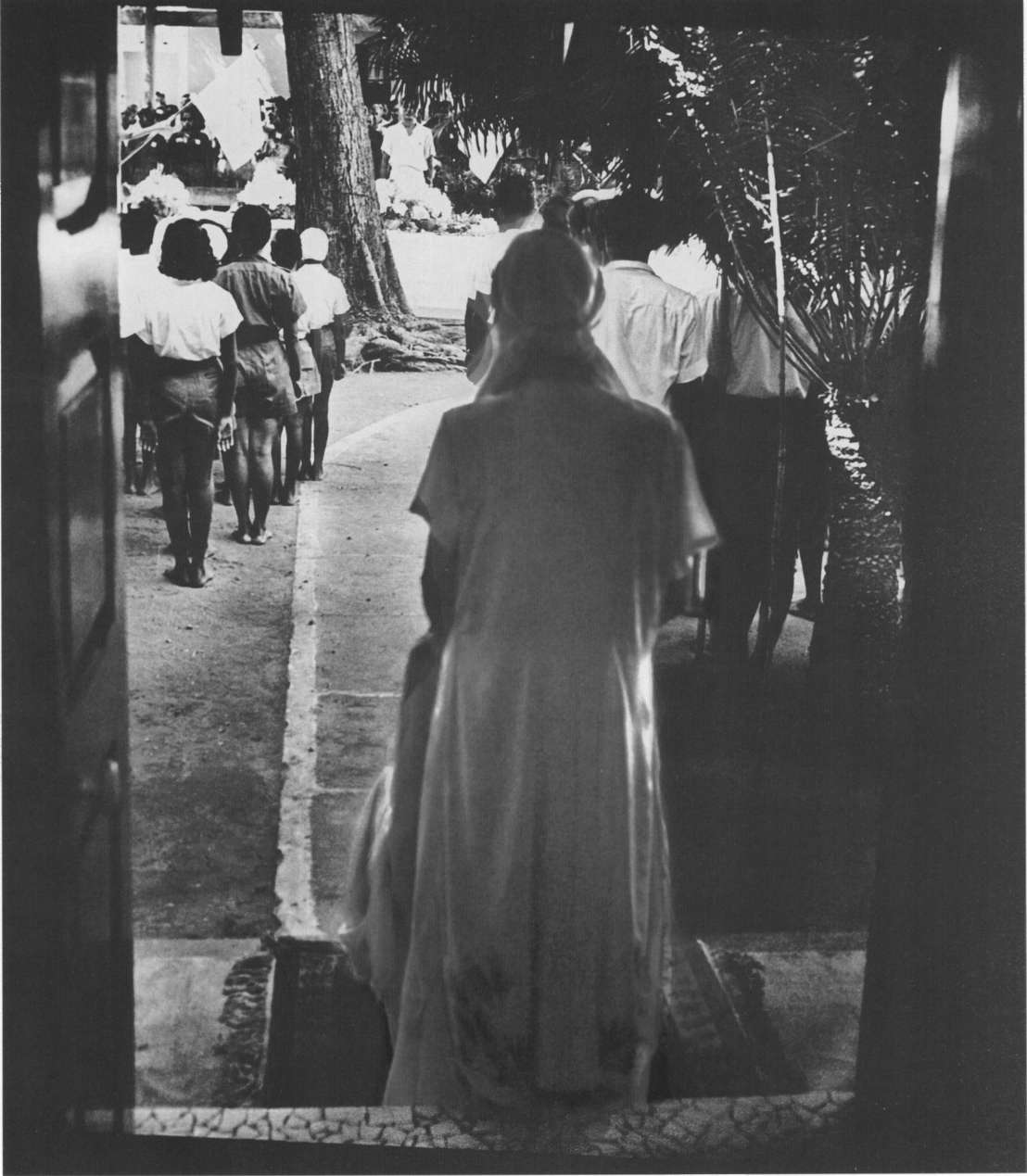
The Mother looking at the Samadhi.
From the beginning, for some years (1950 to 1966), we used to paint the Samadhi with ‘Snowcem’, specially just before Darshan days and whenever it was required. The suggestion to fix marble stones was approved by The Mother in the year 1967 and it was done.
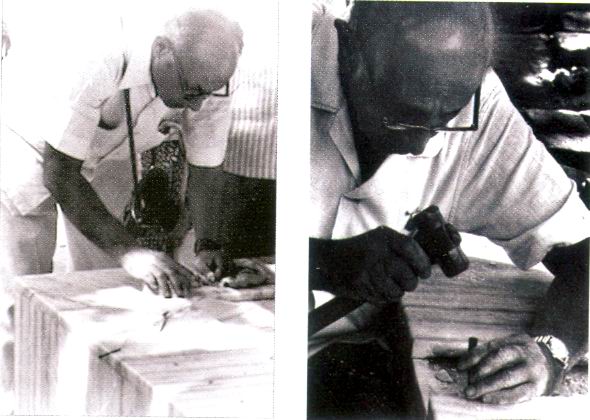
Viswanath Lahiri and Udar Pinto laying the marble on the Samadhi.
In 1966, a bigger offering box was needed, which The Mother sanctioned and it was made in Harpagon and fitted on 1.8.1966.1 was wondering what to do with the old small one. This was referred to The Mother and on 2.8.1966. She sent word through Amrita-da, Saying, “Ask him (Gangaram) to keep it as a souvenir”.
In 1970, there was a proposal by three Sadhaks (K, M & P) that the offering box be made in silver, for which they would bear the expenses. The Mother approved of the idea on 24.2.1970. A silver box was prepared in Madras by A P and brought to Pondicherry. When I took it to The Mother, She was happy to see it and She exclaimed, “Oh! so big!” I said, “Yes Mother”. She opened the box, looked inside and then closed it, giving both the keys to me along with Her Blessings. This was installed at the Samadhi and it continues to be there.
When The Mother left Her body on 17.11.1973, as per the instructions given by Her to Pranab-da, Her body was laid to rest in the second (top) chamber of the Samadhi and sealed with waterproof material. The flower decorations on the Samadhi continued.
 Placing the Mother’s Casket inside the Samadhi vault on 20 November 1973.
Placing the Mother’s Casket inside the Samadhi vault on 20 November 1973.
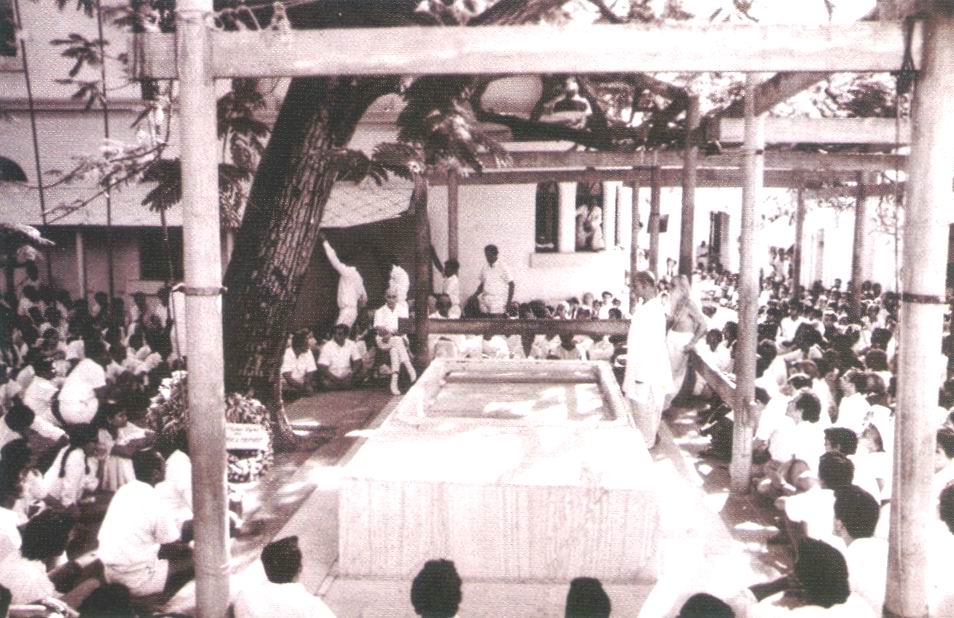
The Samadhi after the Mother’s Casket was put inside the vault (20 November 1973).
After some years, again it became necessary to have a still bigger offering box. The silver box touched and blessed by The Mother was kept as it was, and it continues to be there even now. A new one, this time in stainless steel, was prepared and placed at the corner of the pillar in line with the previous one.
The flower decorations on the Samadhi used to be done early in the morning, from 4.00 a.m. to 5.30 a.m. and this still continues. However, it was found that flowers did not remain fresh till the evening. Hence, in 1984, it was suggested by Nirod-da that the flowers be changed at mid-day, using fresh flowers for the Samadhi decorations and this is what is being done even today.
____________
Photographs courtesy: Ms. Gauri Pinto and Mr. Anurag Banerjee.
I was looking for information regarding placement of their respective earthly bodies in the samadhi, which I couldn’t find in this write up.
The following excerpts might be of some help to you:
‘Mother gave me instructions for the casket which was made of solid wood and lined with silk. Sri Aurobindo was still lying on his bed and there was the most marvellous golden light emanating from his body, and a scent like a celestial perfume. The Mother told me how deep to go into the Samadhi and how to design it.
‘We built the Samadhi not as a hole in the ground but as a vault with thick concrete walls nine inches thick with cement floors and a cement roof. We went down eight feet and built a four-foot room with cement slabs. Over that the Mother instructed me to build another room also with walls, a floor, and a roof. She told me to fill it with clean river sand and to put a large slab on the top. Thus was the Samadhi built.
‘Mother wanted Sri Aurobindo’s ‘Samadhi’ to be under the Service Tree in the Ashram courtyard. She gave detailed instructions, saying how deep we should go and that we should construct a waterproof chamber down below with a waterproof cement slab cover and then an air-space with another waterproof cement slab cover. Then earth was to be filled over this till it came above the surface of the ground, and around it the walls of the Samadhi were to be built.
‘The Mother also told us to prepare a fine case for His body. I got the Harpagon Workshop to start making one in solid thick rosewood with brass straps and brass rings on the side to take the ropes.
‘We started working from the morning of the 5th. We decided to build the Samadhi ourselves without paid labour. The ground was hard—very hard—and breaking it was quite a job. It was decided that the burial would take place on the evening of the 5th. Discoloration of the body generally sets in within 24 hours, 35 hours is the outside limit. But when it was about time for the burial there was no sign of decomposition at all. In fact, even though life had left the body, it was suffused with a golden light and Sri Aurobindo’s face shone with it.
‘On the morning of the 9th, Mother decided that the body would be put into the Samadhi already prepared. The body was placed in the casket and covered with a bed sheet but the face was uncovered. The Mother stood over it and concentrated for quite some time in order, as She explained to us afterwards, to free the physical body from the subtle body and other conscious parts of the being that normally continue to stay with a body for several days after death.
‘Then Mr. R.K. Tandon, the Indian Consul General at Pondicherry… was called in to witness the closing of the casket with the body of Sri Aurobindo inside.
‘After the Mother passed away, we opened up the top chamber. We took the clean river sand that had been lying over Sri Aurobindo’s tomb from 1950 to 1973 and put it into barrels. We made packets from the sand and gave them out to many people and it helped them in sickness and pain and in times of trouble.’
Udar—One of Mother’s Children, pp. 37-38.
thanks for the treasures Anurag
thanks for sharing loving memories.
Salutations –Salutations – Salutations !!!
Surendra s chouhan ’69 SAICE
Thank you, Anurag. Maybe my query was more academic in nature, but now I am fully satisfied with this supplementary information.
I heard the sand is changed every year and distributed to devotees. Is it true.?
Regards
Bhuvana
No Bhuvana-ji. No such thing takes place.
With warm regards,
Anurag Banerjee
sand is changed 10 days before every darshan, ie. 11th feb for feb darshan, washed dried and kept for use again, new sand is brought from riverbed 4-5 kms away , washed dried and kept, for use later, if in pondy you can contact Brahmananda who works there and he might give a packet if in stock, not for distribution at all
Dear Anurag Babu,
Namaskars.
Thank you very much for this informative story.
Regards and Love.
H Acharya
Bhubaneswar
Whenever I visit samadhi I also wonder about how the Gurus’ bodies are laid ie whether their feet are facing towards the little room where books and photos are sold (towards the entrance to the Ashram) or the other direction (towards the meditation hall). It would just be nice to know if I am touching their feet or not. Do we know the answer to this?
According to Satprem (who writes in the first volume of “Notebooks of an Apocalypse” (page 75), Sri Aurobindo’s head is ‘eastward’, that is, towards the Meditation Hall.
Thank you very much.
Dear Anurag ji, If we will get details of Brahmanand ji, shall we request him to send us washed, dried river sand, would be highly appreciated if we get it please,
PRANAM SRI MAA PRABHU PRANAM AT YOUR THY LOTUS FEET.
Esteemed,
Anurag Jee, there are many Holy Relics centre made under the roof throughout India and abroad as it is completely protected from rain water.
As directed by The Divine Mother Lord’s Samadhi was built under the service tree, but there is no roof on top of The Samadhi, open sky and under service tree is ok, but during the heavy rain, and rain water overflow from The Samadhi must be spreading over the ground around the Holy Samadhi which it is touching the feet of the visitors or disciples. Is it not possible to manage a roof over The Holy Samadhi to protect from rain water, Can we transform a little to a roof top instead of using cotton Samina?
I believe past is passed at its own course of time and now the whole things are transformed, so a simple metalic or concrete roof protector may be considered………
I don’t know why such things came to my mind and during heavy rain fall, rain water falling over The Holy Samadhi must be overflow towards Ashram main passing through ground. Such charged water should not be passed through public passage or way definitely. Humble Namaskar